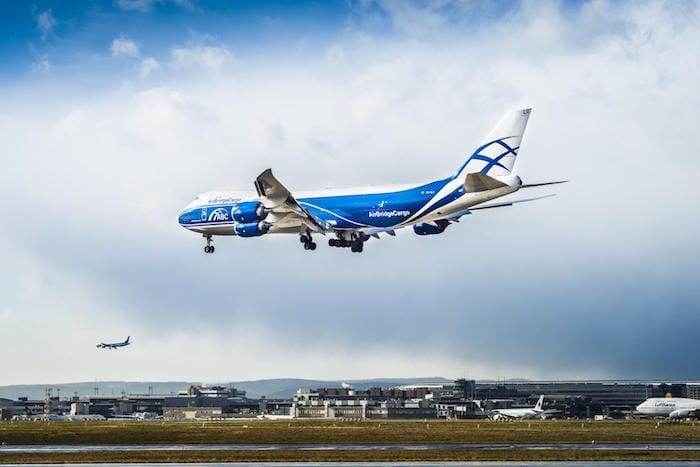
AirBridgeCargo Boeing 747-400. Photo courtesy of AirBridgeCargo
AirBridgeCargo Airlines is in the initial stages of what the Russian freight carrier’s senior IT project manager Vladimir Korzun describes as “Electronic Enablement of Cargo (EoC).”
Korzun told Avionics International the airline still has some decisions to make for investments that will enable a groundbreaking internet of things (IOT) concept involving the tracking of data associated with time sensitive air cargo, such as pharmaceuticals. The concept involves equipping their Boeing 747 fleet with internet connectivity, an onboard IOT edge gateway and cargo-sensing technology.
SITAOnAir first announced the partnership with AirBridgeCargo and London-based CargoLogicAir at the 2018 Farnborough Air Show. Now AirBridgeCargo is moving closer to operationalizing the concept.
“With medicine products becoming more sophisticated, manufacturers set a high level of demands for their transportation. For example, temperature control throughout the whole journey, and real-time information to monitor the status of the shipment as a confirmation of the medicine integrity and consistency,” said Korzun.
SITAOnAir is equipping AirBridgCargo’s fleet with its edge gateway and communications management computer that will acquire data transmitted from air cargo IOT sensing technology supplied by OnAsset Intelligence. The sensing technology from On Asset includes an autonomous real-time tracking device, Sentry 500, and Sentinel tags used to identify individual assets and record sensor values.
The tags log critical sensor and handling information during all phases of flight and offload the data to any Sentry or mobile device within the vicinity. Then, it is transmitted to their ground data management and dispatch platform using available communications channels including ACARS.

SITAOnAir’s specific IOT solution for AirBridgeCargo and CargoLogicAir works by collecting IOT data provided by OnAsset Intelligence, its demo partner and cargo-monitoring specialist, during the course of a flight. This OnAsset Intelligence data is then fed through SITAOnAir’s onboard IOT edge gateway. Photo courtesy of SITAOnAir
AirBridgeCargo General Director Sergey Lazarev, a colleague of Korzun’s, describes the project as creating a “digital pharma” service for its customers that need to track the status of pharmaceuticals on their aircraft.
Right now, AirBridgeCargo is evaluating investment in two additional pieces of aircraft electronics needed to make the concept a reality. These include wireless networking and aircraft interfacing device technology to enable the use of internet protocol connectivity.
“Our aircraft equipment allows us to communicate with the ground over ACARS, using different channels like high frequency, very high frequency data link and satellite communications. SITA is able to provide us with the internet connectivity, but to bring internet on board, we need to have aircraft interface device, as well as wireless network onboard. That is exactly where we are focused now — conceptual development of aircraft internet of things operations,” said Korzun.
The airline is currently in the process of quality and risk assessments of available aircraft interface devices and wireless networking equipment.
According to Korzun, AirBridgeCargo has found that ACARS has enough bandwidth to provide updated information about the conditions of cargo as requested by its pharma customers.
“However, in the future those requirements may change,” said Korzun.
“For example, if a customer wants a real-time video instead of parameters, that would require more bandwidth and solution. That is why aircraft interface device and wireless network should be selected and deployed very carefully with required attention to communication standards and aviation authority certification,” he said.